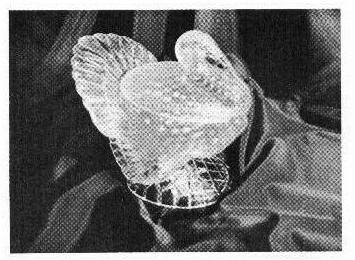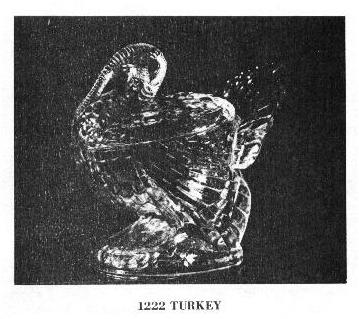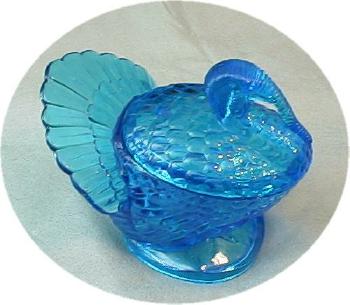Will the REAL Cambridge Turkey please Stand Up
by Charles Upton
Issue #10 - January 1974
The Cambridge Glass Covered Turkey is almost as elusive as the wild
turkeys are today. I have seen seven Cambridge Glass covered Turkeys
and not one of them belong to me. I had to borrow one to write this
article of comparison. The one I own is a crystal covered turkey, like
the one that was featured in a story on the front paper.
 The paper did
not state who the maker or the turkey was but it was not the Cambridge
Glass Company of Cambridge, Ohio. I have these two covered turkeys in
front of me now and will attempt to give as detailed a description of
both as best I can.
The paper did
not state who the maker or the turkey was but it was not the Cambridge
Glass Company of Cambridge, Ohio. I have these two covered turkeys in
front of me now and will attempt to give as detailed a description of
both as best I can.
I will refer to the one turkey as the "copy" (photo at left). The height of the copy is 8 5/8 in. while the Cambridge is 8 1/8 in. from the base to the top of the head. The width of the body, on both is 5 in. The width of the tail is 6 7/8 in. on the copy and 6 3/4 in. on the Cambridge. The depth, from front to back, including the tail, is 8 3/4 in. on the copy and 8 1/2 in. on the Cambridge.
I traced on a piece of paper, a line around the base of the copy and the oval shape measured 4 7/8 in. by 5 3/4 in. I sat the Cambridge turkey on this tracing and drew another line around it. The lines were identical. I did the same with the cover of both and they too were identical, measuring 4 3/4 in. by 6 1/8 in. Could this be an early Cambridge G1ass covered Turkey? Does anyone out there know who really made this one? Some think the Cambridge Glass Co. made it.
It must be remembered, that when an item is hand made, and is a hot
 elastic type material, such as hot molten glass, no two will be
identical in every way. Because of the weight of the glass itself, the
shape of the item could sag or become bent or pulled out of shape in
taking it from the mold while too hot. If you happen to own a covered
turkey produced by the Cambridge Glass Company and these measurements
do not match your turkey, it does not mean that yours in not Cambridge.
The detail should be the factor in determining the maker.
elastic type material, such as hot molten glass, no two will be
identical in every way. Because of the weight of the glass itself, the
shape of the item could sag or become bent or pulled out of shape in
taking it from the mold while too hot. If you happen to own a covered
turkey produced by the Cambridge Glass Company and these measurements
do not match your turkey, it does not mean that yours in not Cambridge.
The detail should be the factor in determining the maker.
The most easily recognizable difference between the two is the underside of the base and the feather detail. The underside of the copy is like a waffle, with eight rows of squares. The underside of the Cambridge base looks like an unfinished casting and is rough. The grooves on the copy, viewed from the top, look like they have been cut into the glass, but upon examining them, are actually raised, with the center part of the square being very smooth. The second most recognizable difference is the fine feather detail on the copy. The feathers on the Cambridge turkey are smooth and the feathers on the copy have a very fine detail.
There are eighteen feathers on the outside row of feathers on the tail of the copy and only seventeen feathers on the Cambridge turkey. There are seventeen feathers on the inside row of feathers on the tail of both the copy and the Cambridge turkey.
On the backside of the copy, there are five leaves whloh look like a type of fern leaf, some grass and a limb with cut-off branches. The Cambridge turkey does not have the detail, but does appear to have the same type of decoration in this area.
The tail of the copy is more rounded and has two layers of feathers,
one on top of the other. One layer, viewed from the rear and one from
 the front, while the Cambridge turkey has only one layer of feathers,
and is the some front and back. The tail of the copy is more rounded
and the Cambridge turkey has a slight point to it.
the front, while the Cambridge turkey has only one layer of feathers,
and is the some front and back. The tail of the copy is more rounded
and the Cambridge turkey has a slight point to it.
There is about ¼in. difference in the thickness of the base. The copy is ½in. thiok at the front of the base, while the Cambridge turkey is ¾in. thick.
The copy faces straight ahead in proportion with the tail while the Cambridge turkey tends to face to the left in proportion to the tail, as may be seen in the photograph at left.
The feet of the copy are 1/8 in. closer to the front edge of the base as compared to the Cambridge Turkey.
The more I compare these two birds, the more I am convinced that the copy is older than the Cambridge turkey and is not actually the copy as I have called it. Could this be an early Cambridge Glass "Covered Turkey"? Does anyone out there know who really made this one? Some think the Cambridge Glass Company made it.
Some have asked if Cambridge Glass Company made a smallerr covered turkey. I have never seen a picture in any Catalog of such an item and do not believe that a smaller turkey was ever made by the Cambridge Glass Company.
